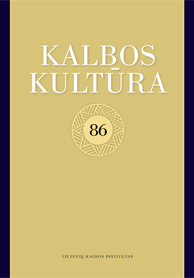PRITARIMAS PAŠNEKOVUI ŽEMAIČIŲ KASDIENYBĖS DISKURSE: FUNKCIJOS IR RAIŠKA (REMIANTIS XX A. II PUSĖS ŠALTINIAIS)
AGREEMENT WITH INTERLOCUTOR IN SAMOGITIAN DAILY DISCOURSE: FUNCTIONS AND EXPRESSION (BASED ON THE SOURCES OF THE 2ND HALF OF THE 20TH CENTURY)
Author(s): Jūratė PajėdienėSubject(s): Theoretical Linguistics, Applied Linguistics, Baltic Languages
Published by: Lietuvių Kalbos Institutas
Keywords: Samogitian daily language; spontaneous dialogue; agreement with the interlocutor; repetition;
Summary/Abstract: In the context of Samogitian interpersonal communication one interlocutor’s agreement with another in terms of the content of speaking and/or emotional support is mostly concerned with familiarity and the social – phatic – function of language. The study made use of the collections that record the Samogitian language of the 2nd half of the 20th century. The material provided by the collections of passages illustrating Samogitian authentic speaking shows the link between the appropriateness of communication and the favourable attitude towards the interlocutor (if permitted by a communicative situation and content). The proper expression of attentiveness is associated with the universal attitudes of appropriate (tactful) communication, which are realized by a calm body posture, eye contact, attention to the interlocutor’s behaviour, and the content of speaking. Samogitians tend to perceive the favourable approach towards the interlocutor’s content of speaking and its way of presentation as politeness and try to show it by varied expression of agreement. The analysis of the discourses of three types contained in the collection of texts illustrating Samogitian authentic speaking Taip šneka tirkšliškiai (cf. Girdenis 1996) reveals different practices of the listener’s agreement with the speaker. The narration of a true or fictitious but interesting story is usually not interrupted by the listener. In a usual conversation of several individuals the agreement of one interlocutor with another (providing new information) is more commonly expressed by the repetition of the interlocutor’s phrase or its part (~65%) rather than the short words expressing agreement (~35%). The structure of phone conversations demonstrates a considerably more frequent usage of elements of agreement with the interlocutor, which is explained by the inability of the interlocutor’s visual evaluation. In the phone conversations under analysis agreement was relatively more commonly expressed by the short words of agreement, which were pronounced by utilizing different voice modulations (~78%), compared to the repetition of the interlocutor’s phrases (~22%).
Journal: Bendrinė kalba (iki 2014 metų – Kalbos kultūra)
- Issue Year: 2019
- Issue No: 92
- Page Range: 1-18
- Page Count: 18
- Language: Lithuanian

